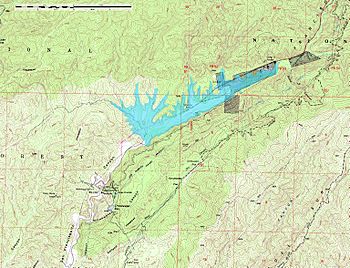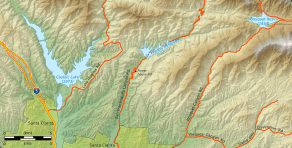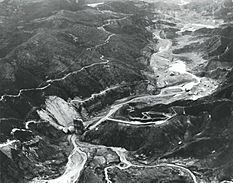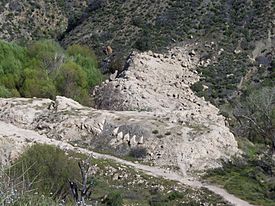St. Francis Dam facts for kids
Quick facts for kids St. Francis Dam |
|
|---|---|
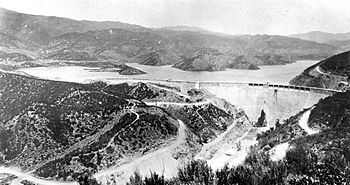
View of the dam looking north, with water in its reservoir, in February 1927.
|
|
| Location | Los Angeles County, California, United States |
| Coordinates | 34°32′49″N 118°30′45″W / 34.54694°N 118.51250°W |
| Construction began | 1924 |
| Opening date | 1926 |
| Demolition date | 1929 |
| Dam and spillways | |
| Impounds | Los Angeles Aqueduct San Francisquito Creek |
| Height | 185 feet (56 m) |
| Height (foundation) | 205 feet (62 m) |
| Length | main dam 700 feet (210 m) wing dike 588 feet (179 m) |
| Elevation at crest | parapet 1,838 feet (560 m) spillway 1,835 feet (559 m) |
| Width (crest) | 16 feet (4.9 m) |
| Width (base) | 170 feet (52 m) |
| Parapet width | 16 ft (4.9 m) |
| Hydraulic head | 182 ft (55 m) |
| Dam volume | main dam 130,446 cu yd (99,733 m3) wing dike 3,826 cu yd (2,925 m3) |
| Spillway type | uncontrolled overflow |
| Reservoir | |
| Total capacity | 38,168 acre⋅ft (47.080×106 m3) |
| Catchment area | 37.5 sq mi (97 km2) |
| Maximum length | 3 mi (4.8 km) |
| Maximum water depth | 182 ft (55 m) |
| Official name: St. Francis Dam Disaster Site' | |
| Reference #: | 919 |
The St. Francis Dam was a large concrete dam built in California. Its main job was to hold and store water for the city of Los Angeles. This water was a key part of the city's water system, called the Los Angeles Aqueduct. The dam was located in San Francisquito Canyon, about 40 miles (64 km) northwest of downtown Los Angeles.
The dam was designed and built between 1924 and 1926. It was created by the Los Angeles Department of Water and Power. The head of this department was William Mulholland, who was both the general manager and chief engineer.
Sadly, at 11:57 p.m. on March 12, 1928, the dam broke apart completely. The huge flood that followed killed at least 431 people. This disaster is one of the worst civil engineering failures in American history. It caused the second-greatest loss of life in California, after the 1906 San Francisco earthquake and fire. The dam's collapse also marked the end of Mulholland's career.
Contents
Why the Dam Was Needed
In the early days, Los Angeles got its water from the Los Angeles River. Water was moved through ditches called zanjas. William Mulholland started working with the city's water company in 1878. He was a very smart worker who taught himself engineering and geology by studying books. He quickly became the Superintendent of the Water Company.
In 1902, Los Angeles took over its own water supply. Mulholland became the Superintendent of the new Water Department. Later, he was named Chief Engineer.
Mulholland became famous for designing and building the Los Angeles Aqueduct. This aqueduct was the longest in the world at the time. It used gravity to bring water 233 miles (375 km) from the Owens Valley to Los Angeles. The project finished on time and under budget in 1913. The aqueduct still works well today.
While building the aqueduct, Mulholland thought San Francisquito Canyon would be a good place for a dam. He wanted a large reservoir to store water. This would help Los Angeles during dry periods or if the aqueduct was damaged. He liked the canyon because it was narrow in one spot, which was perfect for a dam.
Mulholland studied the rocks in the area. He found two main types: a reddish rock called conglomerate on the western side, and a different rock called mica schist on the eastern side. He tested the western hillside and thought it would be a good base for a dam. However, later tests on the eastern side by his construction supervisor seemed to miss some problems with the rock there.
Los Angeles was growing very fast. Its population jumped from 100,000 in 1900 to over 576,000 by 1920. This growth meant the city needed even more water. Several smaller reservoirs were built, but a much larger one was still needed. Mulholland decided to build the new large reservoir in San Francisquito Canyon. This land was owned by the government and was less expensive.
Building the Dam
Planning for the St. Francis Dam started in December 1922. Construction began quietly, without much public attention. This was because the Los Angeles Aqueduct had been damaged by angry farmers in the Owens Valley. The city wanted to avoid similar problems.
The St. Francis Dam was the second concrete dam built by the Bureau of Water Works and Supply. The first was the Mulholland Dam, which was very similar in size. The design for the St. Francis Dam was based on the Mulholland Dam, with some changes for its location.
The St. Francis Dam was curved, but it was designed as a "gravity dam." This means it relied on its own weight to hold back the water. Engineers at the time didn't fully understand how the curve (arch effect) helped with stability.
Initial plans in 1923 called for a dam 175 feet (53 m) high. This would create a reservoir holding about 30,000 acre-feet of water. However, as construction went on, the plans changed. By March 1925, the dam's height was increased to 185 feet (56 m). This made the reservoir's capacity grow to 38,000 acre-feet. Because the dam was taller, a 588-foot (179 m) long "wing dike" had to be built on the ridge next to the western side of the dam. This dike helped contain the larger reservoir.
The dam had a unique stepped design on its downstream side. Each step was 5 feet (1.5 m) high, but their width changed. When finished on May 4, 1926, the dam stood 185 feet (56 m) above the canyon floor. It also had spillways to let excess water flow out and five large outlet pipes to release water.
Problems with the Dam
Water began filling the reservoir on March 12, 1926. It filled up steadily, but some cracks appeared in the dam. There was also some water leaking from under the sides of the dam. Mulholland and his assistant, Harvey Van Norman, checked these leaks. They thought the cracks and leaks were normal for a concrete dam of this size.
In April 1927, the water level got very close to the top of the dam. A leak started near an old fault line on the western side. Workers tried to seal it, but water kept seeping through. A pipe was even installed to collect this water for the dam keeper, Tony Harnischfeger, to use at his home. Mulholland believed the dam was "the driest dam of its size I ever saw," meaning he thought the leaks were very small.
Later in 1927, new cracks appeared in the wing dike and more leaks started under both sides of the dam. By late February 1928, a noticeable leak began at the base of the wing dike. It was releasing about 4.5 gallons (17 liters) of water per second. Mulholland inspected it and thought it was just another crack. When the leak doubled in size, he ordered a drain pipe to be installed. This made the hillside look very wet, which worried people living in the canyon.
On the morning of March 12, 1928, the dam keeper, Tony Harnischfeger, found a new leak on the western side. He was worried because the water looked muddy, which could mean it was washing away the dam's foundation. He immediately called Mulholland. Mulholland and Van Norman came to inspect it. They found the source of the leak and decided the muddy water was from loose soil, not the dam's foundation. They estimated the leak was releasing 15 to 22 gallons (57 to 85 liters) per second. They noticed the flow sometimes surged. Mulholland felt some repairs were needed, but not right away.
After two hours of checking the dam, Mulholland and Van Norman were convinced the dam was safe. They returned to Los Angeles.
The Dam Collapses
Just two and a half minutes before midnight on March 12, 1928, the St. Francis Dam completely broke apart.
No one survived who saw the dam collapse. However, a carpenter named Ace Hopewell rode his motorcycle past the dam about ten minutes before midnight. He didn't see anything wrong. About 1.5 miles (2.4 km) upstream, he heard a rumbling sound like "rocks rolling on the hill." He stopped, but the sound faded, so he thought it was just a landslide and continued on.
At 11:57:30 p.m., there was a sudden drop in power in Los Angeles. Wires near the dam short-circuited, causing a transformer to explode.
The dam's failure was sudden and complete. Within 70 minutes, the reservoir was almost empty. Most of the dam was swept away as 12.4 billion gallons (47 million m³) of water rushed down San Francisquito Canyon. The largest piece of the dam, weighing about 10,000 tons, was found about three-quarters of a mile (1.2 km) downstream.
The dam keeper and his family were likely the first victims. Their cottage, a quarter-mile (400 m) downstream, was hit by the initial 140-foot (43 m) high flood wave.
Five minutes after the collapse, the flood wave, now 120 feet (37 m) high, reached Powerhouse No. 2, 1.5 miles (2.4 km) away. It destroyed the building and killed 64 workers and their families. This caused power outages in Los Angeles. As the floodwaters entered the Santa Clara Riverbed, they overflowed, flooding parts of Valencia and Newhall.
By 1:00 a.m., the water, now 55 feet (17 m) high, destroyed another power substation. This cut power to the entire Santa Clara River Valley and parts of Ventura and Oxnard. A construction camp with 150 workers was hit, and 84 workers died.
Around 1:30 a.m., a telephone operator learned about the dam failure and started calling homes to warn people. A highway patrol officer and a deputy sheriff also drove through the valley, warning residents.
The flood heavily damaged the towns of Fillmore, Bardsdale, and Santa Paula. It finally reached the Pacific Ocean 54 miles (87 km) downstream around 5:30 a.m. By then, the wave was almost 2 miles (3 km) wide and still moving at 6 mph (9.7 km/h).
Newspapers across the country reported on the disaster. Mulholland stated that it looked like the hills forming the western side of the dam had moved. He hired geologists to find out if this was the cause. No earthquakes were reported, so that was ruled out.
Why the Dam Failed
Many investigations looked into why the St. Francis Dam collapsed. Most of these involved panels of famous engineers and geologists. They wanted to find answers quickly.
Most investigations agreed that the dam failed because of problems with its foundation. They believed the ground under the dam was not strong enough. The reddish rock on the western side, especially, became very soft when wet. This weakened the dam's support. When the western side failed, the rush of water then destroyed the eastern side.
The Los Angeles City Council's committee also agreed that "defective foundations" caused the collapse. They said that a leak, no matter how it started, began under the concrete on the red rock side. This leak grew, washing away the foundation material that was already soft from water. This made the dam collapse.
They concluded:
- The dam's design was strong enough if it had a good foundation.
- The concrete of the dam was strong enough.
- An earthquake did not cause the failure.
- The dam failed because of problems with its foundation.
- This failure does not mean that well-designed dams on strong rock are unsafe.
Most experts believed the first break happened on the western side, near the fault line. This area had been a problem since the reservoir first filled with water. They thought that water seeping through the fault line either weakened the foundation or caused a part of the dam to break.
However, some experts, like Dr. Bailey Willis and Carl E. Grunsky, had a different idea. They believed the eastern side of the dam failed first. They thought that water from the reservoir soaked into the schist rock on the eastern side. This made the rock slippery and caused it to move, pushing against the dam. At the same time, the conglomerate rock on the western side swelled when it got wet, pushing the dam from the other direction. This meant the dam was squeezed like in a vise.
They also talked about "hydrostatic uplift." This is when water seeps under a dam and pushes it upward, making it less stable. They believed this uplift, combined with the moving and swelling rocks, caused the dam to break.
What Happened Next
The middle part of the dam that remained standing was called "The Tombstone" by a newspaper reporter. It became a popular spot for tourists and people looking for souvenirs.
In May 1929, this standing section was blown up with dynamite. The remaining pieces were broken down with bulldozers and jackhammers. This was done to stop people from exploring the ruins. The St. Francis Dam was never rebuilt. Instead, the Bouquet Reservoir was built nearby in 1934 to replace it.
The exact number of people who died is still not known. The official count in August 1928 was 385. However, bodies continued to be found for many years, even into the 1990s. Many victims were swept out to sea and never found. The death toll is now believed to be at least 431.
During the investigation, Mulholland said that he and Van Norman had checked the dam on the day it broke and found nothing dangerous. He also said that leaks in large dams were common. Mulholland took full responsibility for the disaster, saying, "If there was an error in human judgment, I was the human, I won't try to fasten it on anyone else."
The investigation concluded that the disaster was caused by "an error in engineering judgment" about the dam's foundation. They said the Bureau of Water Works and Supply and its Chief Engineer were responsible for this error. However, they also said that Mulholland and others could not have known how unstable the rock formations were. The investigation also recommended that building and operating a large dam should never be left to just one person.
Mulholland retired in December 1928. His assistant, Harvey Van Norman, took over as chief engineer. Mulholland continued to work as a consultant. He died in 1935 at age 79.
New Dam Safety Rules
Because of the St. Francis Dam disaster, California created new laws to make dams safer. Before this, cities with their own engineering departments didn't have to follow state rules.
On August 14, 1929, the state was given power to check all non-federal dams that were over 25 feet (7.6 m) high or could hold more than 50 acre-feet of water. The state could also hire experts and oversee how dams were maintained and operated.
Licensing Engineers
The disaster showed that unregulated construction projects could be dangerous. So, in 1929, California passed laws to regulate civil engineering. They created a state board to license civil engineers.
Mulholland Dam Changes
After the St. Francis Dam failed, many people living below the Mulholland Dam (which created the Hollywood Reservoir) worried the same thing could happen there. They asked Los Angeles to drain the reservoir and remove the dam.
Several groups of engineers and geologists studied the Mulholland Dam's safety. They found that the dam didn't have enough "uplift relief." This meant water could seep under it and push it up, making it unstable.
Because of these findings, the Hollywood Reservoir was kept at a lower water level permanently. Also, a huge amount of earth (330,000 cubic yards or 250,000 m³) was placed on the dam's downstream side. This made it stronger against water pressure and earthquakes, and also hid it from public view. This work was done in 1933–34.
Dam's Legacy
Today, the only things left of the St. Francis Dam are weathered, broken pieces of concrete. You can also see rusted parts of the old handrails. These ruins and the scar from an old landslide can be seen from San Francisquito Canyon Road. Large pieces of the dam are still scattered in the creek bed south of where the dam once stood.
The disaster site is a California Historical Landmark #919. The marker says: "NO. 919 ST. FRANCIS DAM DISASTER SITE - The 185-foot concrete St. Francis Dam, part of the Los Angeles aqueduct system, stood a mile and a half north of this spot. On March 12, 1928, just before midnight, it collapsed and sent over twelve billion gallons of water roaring down the valley of the Santa Clara River. Over 450 lives were lost in this, one of California's greatest disasters."
In 2005, San Francisquito Canyon Road was damaged by a storm. When it was rebuilt in 2009, the road was moved away from the original dam site.
National Memorial
On March 12, 2019, a law was signed to create the Saint Francis Dam Disaster National Memorial and the Saint Francis Dam Disaster National Monument. These sites are managed by the United States Forest Service within Angeles National Forest. They are meant to remember the dam's collapse and protect 353 acres (143 ha) of land for recreation and nature.
The St. Francis Dam National Memorial Foundation is a group working to raise money. Their goal is to help the Forest Service build and maintain the memorial and monument. This includes building a visitor's center and a wall with the names of all the victims.
Images for kids


